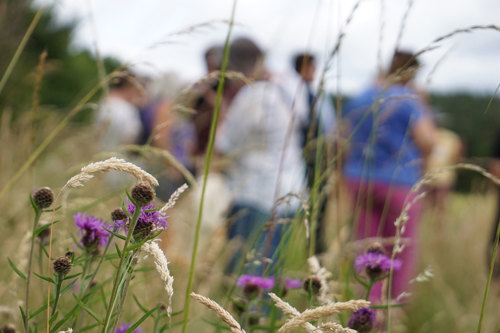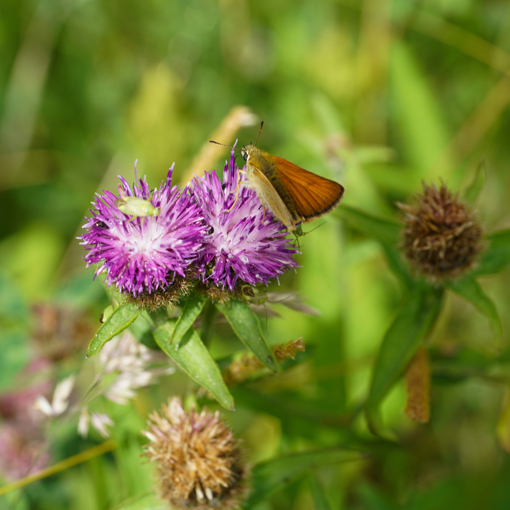Tom Fairfax runs a mixed farm called Mindrum that overlooks the Scottish border on the edge of the cheviot hills in Northumberland. Together with his partner Miki, they manage 80 angus/shorthorn sucklers, 1000 Suffolk Mule ewes and around 300 acres of mixed arable, with an established matrix of agroforestry and agri-environmental projects. In 2022, they are in their second year of organic conversion.

Tom is involved in a field lab in Northeast England investigating flowering habitats for pest control. Together with five other farmers he hopes to unlock more knowledge about how to attract and support the right insect populations to tackle pests in his arable crops.
In this blog he explains how wildflower margins benefit his farm and his reasons for getting involved in the field lab.
What are flowering margins?
Wildflower or Grass Margins are strips of diverse species of wild plants including grasses and wildflowers. These margins are planted round and sometimes through fields to provide a habitat for a range of wildlife that are less desirable in the food production area of the field.
Why are flowering margins important for arable farms?
Nature consists of complex ecosystems where many different species of diverse organisms coexist, feeding, eating and supporting each other. This ‘food web’ operates above, on and below the surface of the ground and is effectively nature’s fertility engine.
In a healthy system, this food web is based on soil microbiology and cascades upwards in a succession of organism groups that are called trophic levels. Each level consumes those below them until we come to animals, birds and ultimately humans.
In most farming models, we manage a simplified environment which creates optimum conditions for our target crop in the majority of the field. This maximises the yield of the target crop and thus increases the output of food, but may not be suitable for many of the other species which make up a balanced natural ecosystem. This means that many natural organisms in the ecosystem may be lost. This includes several predators that naturally control crop pests.
The wildflower and grass margins provide a habitat for those species that may not be so comfortable in a controlled production environment. This enables us to grow the food that we humans need to survive, whilst supporting the amazing plethora of organisms that make up the natural ecosystem.
What benefits do wildflower margins bring to the farm
Some of our grass and wildflower margins have been in place on our farm for nearly two decades. They provide a home for a wide range of wildlife, including mammals, birds, insects and other microorganisms living above, on and below the surface. They also provide a home for a number of predatory organisms that eat the pests that often attack the crop in the field. These include an incredible range of predatory insects and arachnids, in addition to a range of wild birds. Over the years we have noticed that the area close to the wildflower margins is less affected by many of the insect pests affecting crops. So we wanted to get more robust data to back this up.
Why I joined the ‘flower power’ field lab
Whilst we have seen the benefits for years, it has been difficult to quantify the impact. The field lab project aims to measure how far into a crop the beneficial pest control effects of a flowering margin will extend. This will be useful in the future as we develop our ecological balance on the farm. Six farmers across the country, in a range of different management systems are sampling insects at various distances into the field from field margins. They are also using scientific controls by looking at fields without field margins to see if there is a recordable difference.
There is much discussion about the impact of agriculture on nature. Whilst much is valid, there is an enormous amount of positive work going on within the farming community to ensure that we farm sympathetically to the natural environment. Its important that we continue to get better at balancing production with protection of the farmed environment.
Get involved with Innovative Farmers
Sign up to Innovative Farmers and receive a monthly newsletter with opportunities to get involved in the latest farmer-led research.
The field lab is supported by researchers and knowledge exchange advisors from AHDB, Newcastle University, ADAS, and Stockbridge Technology Centre. Stay tuned to Innovative Farmers website to see results and farming advice coming out of the farmer-led research.
Read more about the farming activities at Mindrum Estate on Tom’s blog at https://mindrumestate.co.uk/blog/
Related news

16 November 2021
Nature friendly pest control
Farmers Treating Insects As ‘Livestock’ In Trial To Harness ‘Flower Power’ To Fight Pests

06 February 2020
On farm innovation
Celebrating 100 field labs

14 July 2021
UK fibres